The Intersection of AI and Business Intelligence
In recent years, Artificial Intelligence (AI) has become an increasingly important tool for businesses looking to gain insights and make informed decisions. At the same time, Business Intelligence (BI) has been a staple in the corporate world, providing organizations with valuable data and analytics to drive their operations. The intersection of AI and BI is where these two technologies converge, offering organizations a powerful combination of capabilities to enhance their decision-making processes and drive growth.
AI is the simulation of human intelligence processes by machines, particularly computer systems. It involves the use of algorithms and models to analyze data, recognize patterns, and make predictions based on that data. BI, on the other hand, is a set of tools and processes that enable organizations to collect, analyze, and present data to help them make informed decisions.
When AI and BI are integrated, organizations can leverage the power of AI to enhance the capabilities of their BI tools. This allows businesses to gain deeper insights from their data, identify trends and patterns that may not be immediately obvious, and make more accurate predictions about future outcomes.
One of the key benefits of combining AI and BI is the ability to automate and streamline the data analysis process. AI algorithms can analyze vast amounts of data in real-time, allowing organizations to quickly identify important trends and patterns that may have otherwise gone unnoticed. This can help businesses make faster, more informed decisions, leading to improved efficiency and productivity.
Another benefit of AI in BI is the ability to enhance data visualization and reporting capabilities. AI-powered tools can generate interactive dashboards and reports that make it easier for users to understand and interpret complex data sets. This can help organizations communicate insights more effectively and drive better decision-making across the organization.
AI can also help organizations improve the accuracy of their predictions and forecasts. By analyzing historical data and identifying patterns, AI algorithms can generate more accurate predictions about future outcomes. This can help businesses anticipate market trends, identify potential risks, and make proactive decisions to stay ahead of the competition.
In addition to improving data analysis and decision-making, AI can also help organizations enhance their customer experience. By analyzing customer data and behavior, businesses can gain insights into customer preferences and sentiment, allowing them to personalize their products and services to better meet customer needs. This can lead to increased customer satisfaction and loyalty, ultimately driving revenue and growth.
While the intersection of AI and BI offers a wide range of benefits, there are also some challenges that organizations may face when implementing these technologies. One of the key challenges is the complexity of integrating AI algorithms into existing BI systems. Organizations may need to invest in new tools and infrastructure to support AI capabilities, as well as train their employees to use these new technologies effectively.
Another challenge is the potential for bias in AI algorithms. AI systems are only as good as the data they are trained on, and if that data is biased or incomplete, it can lead to inaccurate or unfair results. Organizations must be vigilant in monitoring and addressing bias in their AI algorithms to ensure that their decisions are fair and unbiased.
Overall, the intersection of AI and BI offers organizations a powerful combination of capabilities to enhance their decision-making processes and drive growth. By leveraging the power of AI to enhance their BI tools, businesses can gain deeper insights from their data, make more accurate predictions, and improve their decision-making across the organization.
FAQs:
Q: What are some examples of AI-powered BI tools?
A: Some examples of AI-powered BI tools include Tableau, Power BI, and Qlik. These tools use AI algorithms to enhance data analysis, visualization, and reporting capabilities, allowing organizations to gain deeper insights from their data.
Q: How can AI help improve decision-making in business intelligence?
A: AI can help improve decision-making in business intelligence by automating and streamlining the data analysis process, enhancing data visualization and reporting capabilities, improving the accuracy of predictions and forecasts, and enhancing the customer experience.
Q: What are some challenges organizations may face when implementing AI in BI?
A: Some challenges organizations may face when implementing AI in BI include the complexity of integrating AI algorithms into existing systems, the potential for bias in AI algorithms, and the need to invest in new tools and infrastructure to support AI capabilities.
Q: How can organizations address bias in AI algorithms?
A: Organizations can address bias in AI algorithms by monitoring and analyzing the data that is used to train their algorithms, identifying and correcting bias in the data, and implementing processes to ensure that their AI systems are fair and unbiased in their decision-making.

